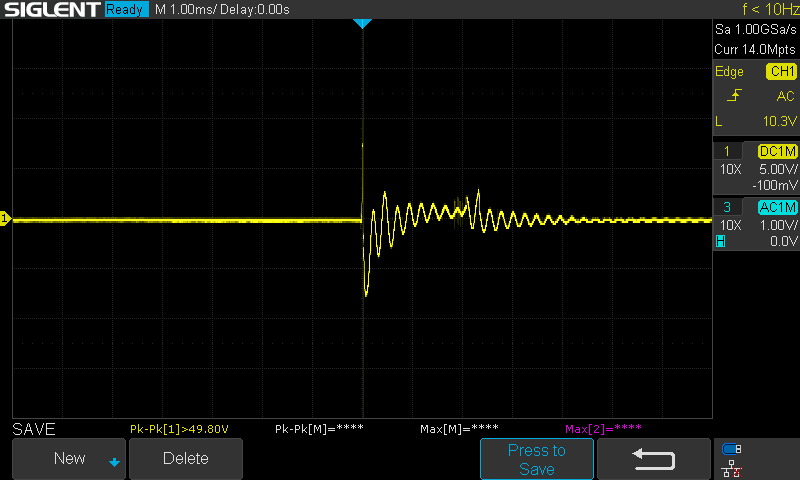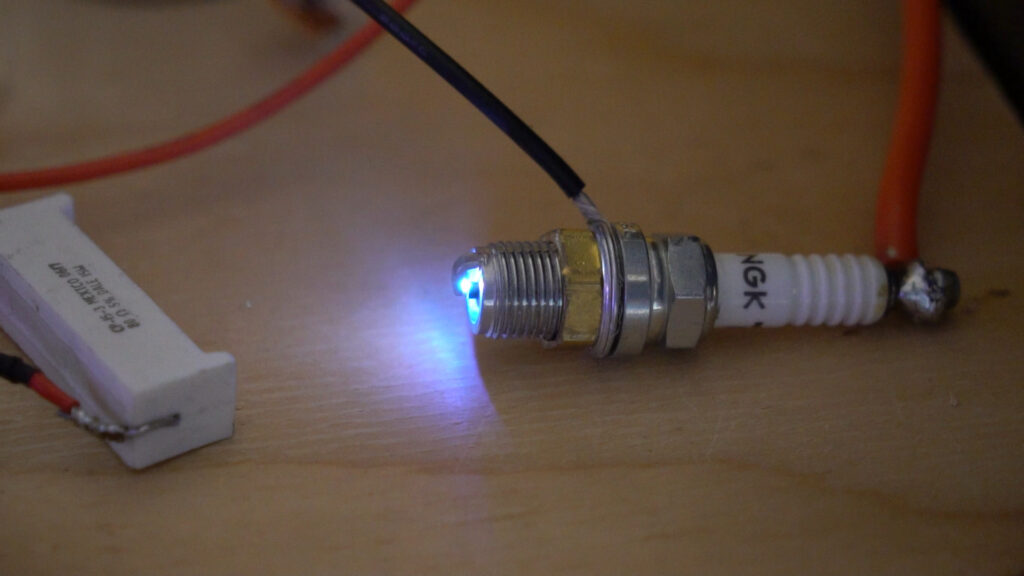The idea for my second experiment came to me when I saw a rather straightforward demonstration of some unusual behaviors from a discharge on a spark plug. A trivial modification to a very simple circuit changed a typical spark (small, purple-ish hue) to a very bright blue-white flash, accompanied by a loud clap. It is not clear to me what is actually happening, but the change is very obvious and beyond the what-is-happening I’m very curious to see what could potentially be used for.
The core of the circuit consists of an electrolytic capacitor, a DPDT relay, an ignition coil & spark plug, and some circuitry to rectify mains to charge the capacitor along with a simple timer to trigger the relay. The capacitor sits on the common terminals of the relay and is switched to be either hooked to the rectified mains, or to the ignition coil and spark plug. It’s really quite basic. I won’t link it directly, but if you search for “plasma spark mod” you will see a few videos of it.


Without the modification, the device behaves exactly as you’d expect: the capacitor is charged (to around 170V for me here in the US), then when the relay is triggered, the energy is dumped into the ignition coil which then generates a spark across the plug. Nothing unusual or surprising.
However, when you add a high-voltage diode from the positive input on the coil to the positive output the resulting spark is far more powerful.
The gentleman giving the demonstration mentions how the behavior changes with the addition of the diode; the discharge happens more rapidly and it’s also mentioned this is a form of Tesla’s radiant energy. I’ve built a version of the device here and can confirm the addition of the HV diode does indeed cause the spark behavior to change. He is also correct in the fact the discharge happens more rapidly, from some careful probing with my scope the waveform changes from a damped sine wave to what looks like a clipped square wave for the first few cycles at least (likely due to measurement limits or the current clamp probe). These cycles are of a longer period as well, so it indeed looks like the energy within the capacitor is being dumped in a shorter period of time. Another item to mention, my circuit (triggered by a 555 similar to the original) was running around 1 Hz; I don’t think it is very relevant but I figured I would mention it.


As for Tesla’s radiant energy and from the few things I’ve read, it does sound like a similar description. Tesla remarked that a rapid discharge was necessary for the phenomenon to manifest and there was a blue glow emanating from the device. I’ve captured some up close high-resolution video with a camera, and while it’s not high-speed (only 120fps), investigating the footage definitely revealed a change in the behavior and something which could be described as a blue glow.


The necessity for a rapid discharge is interesting. Conventional logic would say that a fatter spark is generated, from the increased current flowing. Given what I saw first-hand, I believe this explanation falls short of describing the whole story. I also don’t understand how connecting a diode in this manner would cause the discharge event to change. For full clarity, I’m going off the logic here that the diode changes the electrical behavior of the discharge (shortening it) and this shortening is what is responsible for the spark intensity changes.
Somewhat related, I also observed through chance that the current rating of the diode plays a rather significant role as well. My first tests utilized a 40kv 10ma diode, which resulted in a small blue glow but only a very faint sound. Eventually the device stopped functioning on me and quick troubleshooting suggested the diode died (no surprise), so I replaced it with a microwave oven diode rated at 12kv and 350ma. When this first fired, it scared the hell out of me, as I was not expecting such a drastic change.
I’m also wondering if there is some relation to extended electrodynamics here. And if EVO’s are being produced. If the latter is true, some care should be exercised as I have heard it mentioned that some emissions have been observed in some experiments which generate high-energy or unstable EVOs. When I was successfully able to recreate the more powerful discharge on my end, I took additional precautions and operated it only as necessary and remotely from a good 3-4 meter distance. I also have on order kits for both a geiger counter and a Muon detector, to see if they reveal anything.
As for how this could be used, I’m entirely uncertain at this point. It’s certainly prudent to first ensure some level of safety can be reasonably guaranteed, but what would come next is unknown to me. It would probably require a different apparatus, as this one dumps a small amount of mains voltage across an ignition coil rated for 12V and I imagine it will eventually short-out on me 🙂 However, the mere fact this fairly remarkable event can be easily generated is certainly encouraging to the prospects of a useful application. Furthermore, it lends credence to other devices which include a spark gap in their overall design. Tesla was certainly a fan of them and now I see why!



Leave a Reply